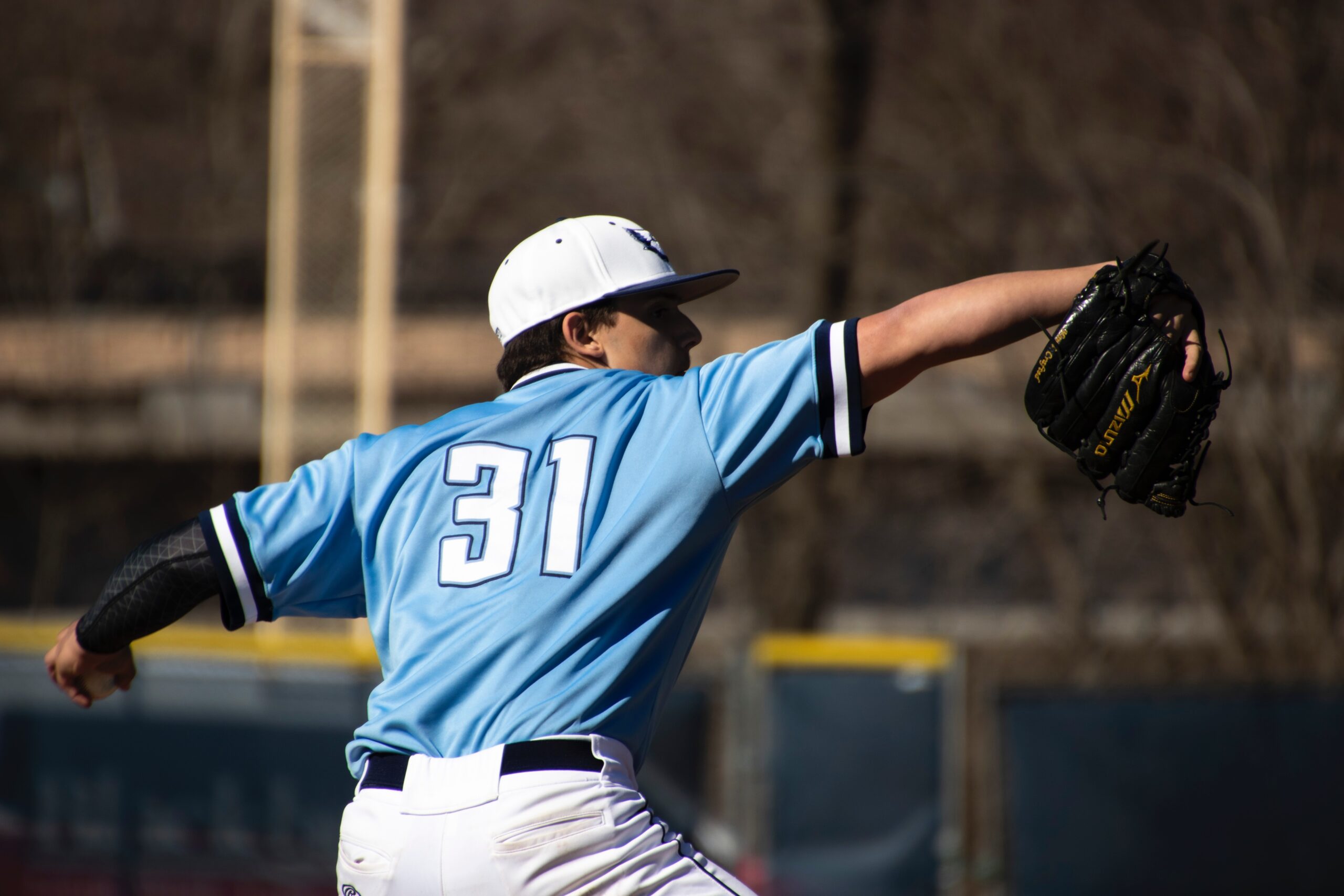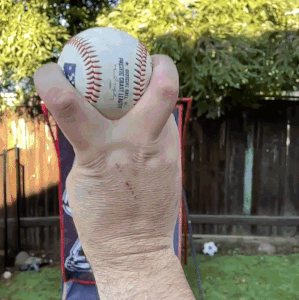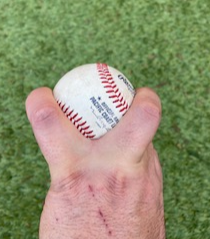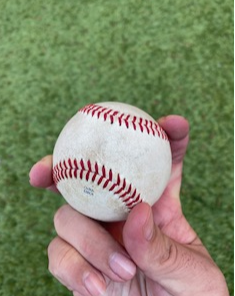One of my favorite topics to discuss is baseball. I love hearing about people’s passion for the sport. It doesn’t matter their skill level or how long they have played. I’ll talk baseball with just about anyone.
Often when someone finds out I played college baseball and I was a pitcher, they will ask, “what was your best pitch”?
My response is always the same. A pretty sarcastic reply with, “It depended on the count.”
Some pitchers might also respond with ‘My next pitch’ as our coach always taught you are only as good at the next pitch/play/game.
But really, one of the nastiest pitches I was able to throw was the split-finger fastball. This article will break down the splitty.
I will recap my experiences on how I learned to throw it, and some tips and tricks I learned later on that I wish I had known in the beginning. We’ll also take a look at some of the best to throw the split-finger fastball.
Contents
Throwing Split Finger Fastball Prerequisite
You know what they say about guys with long fingers? That’s right, they can throw a good split-finger.
I’m sorry, but it’s true. Some people just can’t throw a split-finger fastball.
It has nothing to do with skill or ability and everything to do with how long your fingers are.
And in some cases, your knuckles need to be double-jointed.
Your fingers need to be able to stretch across the ball comfortably and still allow you to control the pitch.
You also don’t want to be digging your hand down at the ball while trying to get the grip, as your could start tipping your pitches to the batter.
If you cannot comfortably hold the ball between your fingers, you must try to learn to throw a slider or curveball.
3 most Common Split Finger Grips
The first way I learned to throw a split-finger was with the split between the seams.
The hard part with this grip is it’s actually the wider part of the ball.
So your fingers need to be very wide in order to throw it.
Split Seams
When you throw the pitch you need to throw it as hard as possible and let the ball actually slip through the back of your fingers.
Sorry for the scars on my hand, we just got a new puppy and her teeth are sharp!
Across the Seams
I started throwing the split-finger across the seams as I entered college. This ball’s side is a bit smaller and easier to grip.
I felt like I could get more control of the pitch, although it didn’t break quite as sharply in my opinion.
The biggest benefit for me, as I didn’t have to really dig in to get the grip, so I could hide it better from the batter.
This is the grip I used the most during my college days.
With the Seams
Late in my college days I had a coach teach me to throw the ball with the seams.
I tried this method, which gave me way more control and side spin.
I still had downward movement, and produced a ton of ground balls; however WAY fewer swings and misses.
I liked the throw my split finger ahead in the count. 0-2, or 1-2 so I liked the strikeouts.
I quickly moved back to method 2. Each of these methods would work for you. Give each a try and see what works.
What age can kids start throwing a split-finger?
Really as soon as your kids have long enough fingers, a split-finger is possible.
Many kids in little league won’t be able to grip the ball this way, so it would be extremely rare for a little leaguer to throw this pitch.
I started messing around with it as a high school sophomore and throwing it in games my junior season.
One of the risks of throwing a split-finger is added pressure to your elbow.
Take a ball and push on the inside of your elbow with a fastball grip. Once you split your fingers apart and grip the ball the inside of your elbow is now flexed.
Some split-finger fastball pitchers have seen elbow injuries over time. Lucky for me I never really had elbow issues as a pitcher.
Split-finger movement
Split-finger fastballs are meant to be thrown hard. They look like a fastball arm motion.
However, the ball slips out the back of your fingers, almost coming out like a knuckleball.
The ball will dance a bit and move sharply down and into a right-handed hitter.
Not only do you get a change of speed (10-15 MPH slower than a fastball) but you also get some nasty movement.
The only real issue here is when you ‘hang it’ meaning you get too much spin or rotation on the ball.
When this happens, you will not get the intended movement, and it just floats over the middle of the plate like a slower fastball.
Some of the hardest-hitting balls I gave up was when I missed on my split-finger fastball.
How do you throw a split-finger fastball?
The most important part of throwing a split-finger fastball is getting the ball to slip out the back of your hand.
I would always practice this when playing catch. I would use the first grip above across the seams. I would play catch at a close distance and try to get the ball to knuckle (not spin).
Once you get that feeling, slowly move back from there. Start throwing it harder and harder until you can throw it with your same fastball motion.
One way to help you get used to the grip is to hold the grip while not playing baseball. I would sit with the grip while watching TV or sitting in class to help me get used to holding the ball that way.
The more comfortable you can get with the grip, the better your chances of successfully throwing this pitch.
As you throw it more, you will get the same feeling as you did at short distances, however, the ball will spin a bit.
However, you should start seeing a sharp downward break on the ball. Once you have this down, you can start trying it on the mound.
Split finger velocity
How hard or fast should your split-finger fastball go? Remember, your split-finger should be thrown with the same.
The velocity should be about 5-10 MPH slower than your fastball. If you throw a fastball at 90 MPH, your split-finger should be around 80-85 MPH.
Some people think a split-finger is just a slower fastball, and the drop is due to the lack of velocity. However, if you let the ball slip out of the back of your hand with a knuckle-type movement, then you start getting some nasty break downward.
Who threw the best split fingers?
Bruce Sutter was one of the first pitchers to throw the pitch. He was injured and looking for a new pitch as he made a comeback with slower velocity.
He started working on the splitter and it helped prompt his comeback
Here is a quick video showing some of the best split fingers in the game. The list includes some of the best players ever to throw the split-finger. ENJOY!
Masahiro Tanaka
Somebody forgot to tell Tanaka that his Split-Finger Fastball isn’t suitable for all audiences pic.twitter.com/zfmAEkWEuH
— Bobby Bandelow (@B_Bandelow) October 9, 2017
Matt Shoemaker
Matt Shoemaker’s Split-Change Grip + Release for the admirably pitching obsessed @PitchingNinja pic.twitter.com/0kak4ACbEJ
— Nick Pollack (@PitcherList) May 23, 2016
Koji Uehara
Let Koji Uehara enter today’s negotiations please.
— Tyler Milliken ⚾️ (@tylermilliken_) March 1, 2022
I truly believe that man can close out anything. 🤷🏻♂️#RedSox | #DirtyWater | #MLBpic.twitter.com/26dnIufRtx
Kevin Gausman
Kevin Gausman’s Mind-Blowing Splitter Grip!
— Rob Friedman (@PitchingNinja) February 9, 2022
Gausman discusses his Split in amazing detail. Not sure if anyone has deeper knowledge of a single pitch
If you’re a Pitcher, a Coach or Fan, you won’t want to miss it!
10 minutes of Splitter talk.
Watch–> https://t.co/QWwKBBEdrv pic.twitter.com/Xchuf9hoR9
Hishashi Iwakuma
Kevin Gausman’s Mind-Blowing Splitter Grip!
— Rob Friedman (@PitchingNinja) February 9, 2022
Gausman discusses his Split in amazing detail. Not sure if anyone has deeper knowledge of a single pitch
If you’re a Pitcher, a Coach or Fan, you won’t want to miss it!
10 minutes of Splitter talk.
Watch–> https://t.co/QWwKBBEdrv pic.twitter.com/Xchuf9hoR9
Jake Odorizzi
Jake Odorizzi goes 5.0 shutout innings in his rehab start with CC!
— Corpus Christi Hooks (@cchooks) June 30, 2022
Odorizzi strikes out 6 against 3 hits (2 infield knocks), throwing 54 of 78 pitches for strikes. pic.twitter.com/CY1OrDFMVk
Wrap up
Remember if the split-finger is uncomfortable to throw, then you shouldn’t be throwing it. That goes for any type of pitch, really. The key to throwing a good split-finger is to practice.
Follow these steps and try to perfect the craft to find a ton of success. Make sure you experiment in the bullpen before throwing it in a game.
It’s always a good idea to ask a coach or the catcher what the pitch is doing. It’s ok to fool around with different grips and go with what you are most comfortable with.
Keep practicing!
Coach Scott








